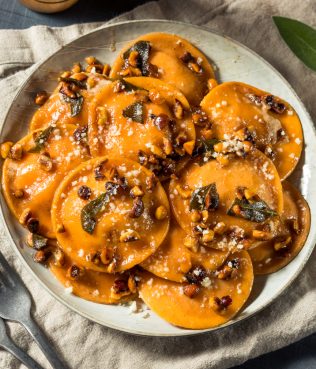
Greek Ravioli with Kalamata Figs, Arugula, Goat Cheese
Inspired by ravioli, one of the great comfort pastas, I created this Greek version with Kalamata figs, onions, and a mild, slightly sour, soft cheese called Katiki, which you can replace with ricotta, Greek anthotyro or even quark. To find some of the artisinal Greek products you'll need to make this, visit my online shop
here, where you'll discover a host of lovingly curated Greek ingredients.
Ingredients
- Serves 4 to 6
- 1 cup fine semolina flour
- 3/4 cup all-purpose flour
- 1 scant teaspoon salt
- 2 eggs
- 2 teaspoons olive oil
- 2 teaspoons water
- 1 cup fresh Greek anthotyro or Ricotta drained
- ½ cup crumbled Greek feta
- Salt and pepper to taste
For the Sauce
- 1/3 cup extra virgin Greek olive oil plus more for drizzling
- 4 large red onions halved and cut into thin slices
- Pinch of salt
- 2 tablespoons balsamic vinegar
- ½ cup dry red wine
- 8 dried Kalamata figs stems snipped, soaked in warm water
- 1 bunch arugula trimmed and chopped
- Greek sea salt and pepper to taste
- Red peppercorns for garnish
Instructions
-
Make the pasta: Place the two flours and salt in the bowl of a food processor. Pulse on and off a few times to combine. Break the eggs over the surface of the flour. Pulse to combine and add the olive oil and water in increments, just until a dough mass forms. Remove it from the bowl of the processor and knead it slightly on a lightly floured surface until it is firm. Set aside for at least 30 minutes, wrapped in plastic. (You can make the dough a day ahead, too, and store it well-wrapped in the fridge.)
-
When ready to roll out the pasta, mix together the drained anthotyro or Ricotta and the feta. Season to taste with salt and pepper.
-
Divide the pasta into 6 equal balls. Lightly flour the cylinders of a pasta maker with cornstarch. Set the gauge on its widest setting. Pass the first ball through to get a strip. Tighten the gauge to the next immediate setting and pass the strip through again. Continue tightening the gauge and passing through the dough strip several more times, until you reach number 2 or 3. The pasta strip should be thin but also strong enough to hold the filling without breaking or tearing. Lay the strip down on a work surface that you’ve dusted lightly with cornstarch. Continue with the remaining dough until done.
-
Place the first strip in front of you on a floured work surface and place a heaping teaspoons of the cheese filling two inches / 5 cm apart all along the strip. Fold over lengthwise to cover and cut the ravioli, either using a ravioli cutter or a knife to get either half-circles or rectangles. Have a glass of water nearby. Dip a finger in the water and press each individual ravioli closed. Set aside on large trays or sheet pans that have been dusted with cornstarch. Continue until done.
-
Make the sauce: Heat the olive oil in a large, heavy frying pan or wide, shallow pot. Add the onions. Sprinkle with salt. Cook, stirring occasionally, over low heat until the onions caramelize, about 20 minutes.
-
While the onions are cooking, drain the figs and reserve their soaking liquid. Chop or slice the figs.
-
Add the balsamic vinegar and wine to the onions. As soon as the wine steams up, add the figs and their liquid. You can add a little warm water if needed, to keep the sauce moist. Simmer the onion-fig mixture until thick. Add the arugula right at the end and toss to wilt slightly. Season to taste with salt and pepper. Set the sauce aside, covered.
-
Bring a large pot of water to a rolling boil and add salt. Cook the ravioli until they rise to the surface of the water. Remove with a slotted spoon to a serving bowl or platter. Spoon the hot sauce over the ravioli. Drizzle more olive oil on top and garnish with crushed pink peppercorns and grated Greek kefalograviera cheese or parmesan. Serve immediately.









